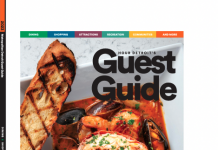
Metropolitan Detroiters are enjoying wine more than ever. We’re drinking more of our old favorites and trying lots of new and exciting wines from all over globe. Americans are quaffing more wine than the French or Italians! We’re the No. 1 market for wine sales when measured in dollars, and this trend is onward and upward. Glance around your favorite restaurants and you can’t help noticing how many bottles of wine are gracing the tables.
From baby boomers to millennials, folks in and around The D are consuming wine as aperitifs, in lieu of cocktails, and pairing wine with their meals. What is behind these trends? More wine is being produced than ever and, for the most part, the quality has never been higher. It’s a great time to be a wine drinker. Let’s look at what is happening now — and what is on the wine horizon.
The Big Three, With A Twist
Many mature, wine-savvy guests are drinking less but better. They have been “around the block” and prefer traditional choices. Established brands rely on this group for continued sales. Merlots, Chardonnays, and Cabernet Sauvignons are frequent selections. Ratings are important to them. Surprisingly to many, Merlot is the No. 2 red wine varietal in the country according to The Nielsen Co. (of television ratings fame). Yes, just as you thought, Cabernet Sauvignon is the top seller. But many of us associate Merlot as a high quality wine at an affordable price that is versatile and food-friendly. To paraphrase Mark Twain, “rumors of Merlot’s death have been greatly exaggerated.”
Chardonnay, the most popular varietal in the U.S., has seen significant style changes recently. For years, big, buttery, tropical fruit-styled Chardonnays were the standard by which many white wines were judged. Happily, wines of balance and finesse are supplementing many of these over-oaked monsters. Unoaked Chardonnays are now all the rage, with descriptions such as unwooded, oak-free, and the classic, “naked,” right on the label. These unoaked Chardonnays reflect the desire for less manipulated wines. They are lighter, elegant and are much easier to pair with food than their woody predecessors.
 Low Alcohol, Bubbles, and a Touch of ‘Sweet’
Low Alcohol, Bubbles, and a Touch of ‘Sweet’
Lower alcohol is also in vogue with many diners. Huge, awkward, high-alcohol wines needing years of aging are passé on many lists. We want wine paired with our meal that is in sync, balanced, and food-friendly. Unless it’s a dessert wine, most bottles over 14 percent alcohol are rather aggressive. Some sommeliers have even pared their lists down, offering only wines under that 14 percent alcohol benchmark.
Sparkling wines have always been popular for special occasions and during the holidays. After all, New Year’s Eve is the night for bubbly! A major trend is sparkling wine, anywhere, anytime, for any or no reason at all. From bone-dry Brut to sweet and fruity sparkling Moscato, bubbles are booming. While purists may stick to strictly Champagne, sparklers from all over the world are more and more popular every day. Michigan’s own Larry Mawby, a pioneer in producing world-class bubblies, makes stellar wines in the tradition of Champagne. Everyone enjoys celebrating. Sparkling wine adds a festive mood to any occasion, say, Tuesday night with appetizers and a salad. Sure, let’s indulge!
As generations of Detroiters have grown up drinking Faygo, Vernors, and other soft drinks, many of us like our beverages with a bit of sweetness. Wine is no exception. Traditionalists have long enjoyed ice wines, Sauternes, and Ports for dessert. Now many red wines are made with just a hint or more of residual sugar. This means that the winemaker does not ferment all of the sugar from the wine as is customary with most wine. By leaving some of the sugar in the wine as it ages, the finished product is has a roundness and softness on the palate. Those tough tannins are gone, resulting in an easily drinkable beverage delicious all by itself. Key words here are jammy and silky rather than sweet.
The Right Blends
In addition to the trend of softer, more accessible wines, Detroiters are drinking many more blended wines. While popular in France, especially Bordeaux, for eons, wines using grape blends are hitting the sweet spot on wine lists. Variations of the classic Bordeaux blend of Cabernet Sauvignon, Merlot, Cabernet Franc, Petit Verdot, and Malbec can be more fun and interesting to enjoy than bottles of just one grape varietal. Another popular red blend with French origins is Grenache, Syrah, and Mouvedre. Rich, deep and spicy describe this hearty combination of grapes from Southern France. As Master Sommelier Claudia Tyagi, tells it, “Younger wine drinkers have a real thirst for knowledge. They’re really exploring the great 2009 vintage from Bordeaux and the Rhone Valley.”
Creativity reigns with white blends as well. Artisan winemakers combine Riesling, Pinot Grigio, and Gewürztraminer to produce a delightful mosaic of aromas and flavors. The classic melding of Sauvignon Blanc and Semillon is enjoying a revival with many wine enthusiasts.
 A Taste For Adventure
A Taste For Adventure
While baby boomers frequently keep within their wine comfort zones, younger enthusiasts are very adventurous. On the hunt for new and exciting tastes, they are flexible and have a zest for lesser-known wines. Two in three millennial wine drinkers frequently purchase a brand of wine they have not heard of or seen before.
Whether you’re a traditionalist or living on the edge, we’re all experimenting with wines and regions. Moscato is the hottest wine in Metropolitan Detroit — hands down. Fruity, flavorful, aromatic, and low in alcohol, Moscato hits all the right notes for a growing number of enthusiasts. Originally from the Piedmont region in Italy where it’s known as Moscato d’Asti, this slightly sweet sparkler works well as an aperitif, with lighter dishes, and simple, fruity desserts.
Malbec is a versatile, easy to drink red wine. Priced right, with abundant fruit, this Argentinean charmer is on everyone’s “must try” list. Black cherry and blackberry aromas are followed by spice and smoke flavors. This full-flavored South American is a perfect match for all types of meat dishes.
Torrontés is the white wine of Argentina. Flowers, peaches and sweet orange blossom aromas jump from your glass. Is it wine or perfume? This exuberant varietal’s flavors of melon and citrus pair well with lighter foods, or as an aperitif. A great value, Torrontés is challenging Pinot Grigio as an alternative to Chardonnay.
Riesling’s Rise, and Other Heritage Grapes
One of the six noble grapes in the wine world, Riesling is on the move. From fun and fruity to elegant and cerebral, Riesling surprises many novices and aficionados alike. From bone-dry to sweet dessert wines, Riesling is no longer underappreciated by those “in the know.” Perhaps the most food-friendly wine in the world, the myriad styles of this ancient grape are sure to please your palate.
According to Tyagi, “Cabernet Sauvignon is still king but ‘heritage grapes’ are becoming much more popular.” Heritage grapes are those varietals indigenous to the area from which they originate.
Greece produces numerous wines from heritage grapes. Moschofilero (mosko-FEE-luh-roh), is made from grapes with a pink/purple skin that produces a refreshing rosé-like wine. The white grape Assyrtiko-Santorini (Ahs SEER tee koh Santo rini) has been cultivated for 3,500 years (give or take a decade) on the stunningly beautiful island of Santorini.
Most of us are familiar with Chianti, Pinot Grigio and Barolo from Italy. Aglianico (ahl-YAH-nee-koe), from central and southern Italy is a spicy, earthy, and powerful example of a heritage grape. Nero d’Avola, a black Sicilian grape, has rich plum flavors and spicy tannins. It’s frequently compared to Syrah.
 Great Values From Abroad — and Our Back Yard
Great Values From Abroad — and Our Back Yard
Spain is crafting many delicious wines that are great values. Portugal is producing earthy, full-bodied wines from grapes formerly used only for Port. And let’s not forget Michigan! We’re home to many world-class wines from the Leelanau Peninsula and the Old Mission Peninsula. If you haven’t recently sampled a Riesling, Pinot Gris, or Gewurztraminer from the Great Lakes state, you’ll be amazed!
As our tastes change, wine lists reflect our new preferences. Gone are the bulky, intimidating wine book/lists of the past. Instead, fun, user-friendly lists are growing in popularity. Describing wines by flavor profiles such as Crisp & Clean, Elegant & Aromatic, or Rich & Round for white wines makes selecting the perfect accompaniment so much easier for us. Smooth & Silky, Rich & Fruity, and Big & Bold are examples of categories for red wine choices. Lists are much more flexible, some changing with the menu as we eat more local foods that are in season. Lots of lists make it so simple to pair your wine choice with your choices: they offer wine(s) already paired with the menu items. It doesn’t get any easier!
Michael Schafer, Esq. (aka The Wine Counselor) is a sommelier and an instructor at The International Culinary Schools at The Art Institute of Michigan. His trademark phrase is, “I taste bad wine so you don’t have to.”
|
|
|









